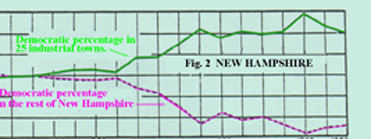
The party process is thrown into a different interpretative framework if one supposes the
existence of processes of long-term, or secular, shifts in party attachment among the voters.
Events and communications of political import play upon the electorate continuously; election
returns merely record periodic readings of the relative magnitudes of streams of attitudes that are
undergoing steady expansion or contraction. Some elections may be "critical" in that they
involve far wider movements and more durable shifts than do other elections. [1] Yet the rise
and fall of parties may to some degree be the consequence of trends that perhaps persist over
decades and elections may mark only steps in a more or less continuous creation of new loyalties
and decay of old. The slow rate at which that process may occur suggests the potency of the
frictions to change built into the electorate by its attachment to old symbols, old leaders, and old
parties. Only events with widespread and powerful impact or issues touching deep emotions
produce abrupt changes. On the other hand, other processes operate inexorably, and almost
imperceptibly, election after election, to form new party alignments and to build new party groupings.
The establishment of the existence, the form, and duration of secular partisan realignments is not
readily accomplished. The ideal data for the purpose would consist of political life histories,
extending over several generations, of random samples of population categories. Until such data
miraculously become available, the only alternative is to search oute lectoral areas in which
specific kinds of people are concentrated and to analyze the voting behavior through time of the
people of such areas.That procedure carries with it all the limitations of the analysis of
aggregates and others as well. Nevertheless, a few illustrative cases, drawn from the states of
upper New England, will be set out to indicate the plausibility of the assumption that secular
change occurs. These bare facts will lay a basis for a consideration of the factors that produce
such alterations and of their probable significance for the party system.
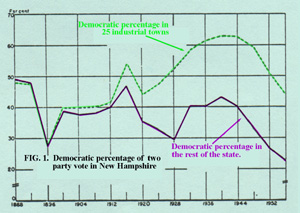 Figure I shows the changes in the Democratic percentage of the presidential vote in 25 industrial
towns of New Hampshire over the period 1888-1956 as well as the Democratic percentage of the
vote in the remainder of the state. Before 1900 the industrial towns and the more rural areas,
each in the aggregate, divided between Republican and Democrats in almost exactly the same
proporations, a fact reflective of the tendency of the parties at that time to split the population
along lines other than that of urbanism-ruralism. [2]
Figure I shows the changes in the Democratic percentage of the presidential vote in 25 industrial
towns of New Hampshire over the period 1888-1956 as well as the Democratic percentage of the
vote in the remainder of the state. Before 1900 the industrial towns and the more rural areas,
each in the aggregate, divided between Republican and Democrats in almost exactly the same
proporations, a fact reflective of the tendency of the parties at that time to split the population
along lines other than that of urbanism-ruralism. [2]Over a half century, as may be seen from the Figure, the electorate of the industrial towns, in
comparison with that of the remainder of the state, became gradually more and more disposed to
vote Democratic. Beginning about 1900 the lines of party division in the two sorts of population
gradually diverge. The spread between rural and urban voting behavior did not increase
uniformily from election to election; exceptionally rapid growth in the differences occurred from
1916 to 1928. Over the entire period a secular trend seems to have been in motion beneath the
cyclical and short term variations in the division of the vote between the parties.

In Figure 1 secular and cyclical movements are mixed; the form of the curves obscures the
secular trend. In Figure 2 the cyclical component of the phenomenon is more or less removed
from the data by showing the Democratic percentages in our 25 industrial towns and in the
remainder of the state as deviations from the Democratic percentage of the vote of the entire
state. This treatment of the data brings out the fact that the people of the two sectors of the state
began to divide differently in their voting about 1900; their differences increased gradually in a
movement that had apparently run its course by 1952. The chart also makes apparent the special
character of the events of individual campaigns. Some accelerated the long-term movement;
others retarded it.
An analysis that places emphasis on another aspect of the phenomenon appears in Figure 3,
which shows the changes in the proportion of the Democratic presidential vote of Maine
contributed by the 25 principal industrial towns and cities over the period 1888-1952. It also
shows the percentage of the state's Republican vote contributed by the same towns. Figure 3
brings into salience the fact that over the period1888-1952 a larger and larger proportion of the
Democratic vote of the state came from the industrial towns and cities; the Republican party, on
the other hand, remained dependent in roughly the same degree on its support in these localities.
[3] The growing dependence of Democratic candidates on the urban vote came inpart from
losses in the country, but the principal explanation of the trendline is that the Democratic vote in
the industrial towns grew more rapidly than did the Republican vote there..
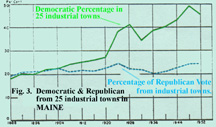
The Vermont trends, although less marked in extent, resemble those inNew Hampshire and Maine. The Vermont figures were put through a different process than were those for the other two states. The shift in areas were defined directly in political terms rather than indirectly in demographic terms. Those towns with 20 points or more gain in Democratic percentage of the presidential vote from 1896 to 1948 (excluding towns with less than 100 votes in 1948) were identified. Then the Democratic percentages for the aggregate of these towns at the intervening elections were computed. This procedure yielded the results shown in Figure 4.
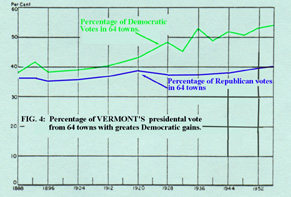
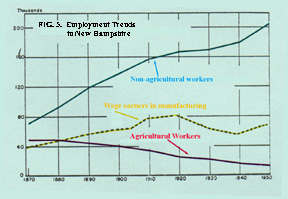
In the examples inspected, a long-term partisan reorientation has been associated with the introduction of new population elements, but perhaps these are only special cases of a broader class of phenomena. We may presuppose the existence of processes categories of people, under specified conditions, gradually approach political homogeneity. This process may or may not be associated with the introduction of new population elements. Its essential quality, for the present analysis, is the fact that a substantial category of persons, defined by a common characteristic, demographic or otherwise, moves over a long period of time toward a partisan homogeneity.
If it be granted that long-term processes of development of group political homogeneity exist, the explanatory problemarises. That problem has two aspects. First, what sets the change in motion? Second, how cant he slowness of the process be explained?
The odds are that some objective change in the status of a group of persons is the condition most frequently associated with such a long-term partisan shift. Thus, the rise of an industrial working class places a category of persons in a new set of relations with other elements of society. That change in itself does not produce a realignment but it creates opportunities for exploitation by political leadership. Agitation tothat end may be aided by a sequence of events whose impact reenforcesthe oratory of the agitator. The Bull Moose movement, Wilsonianprogressivism, the little depression of 1921. the candidacy of Al Smith in1928, the great depression, and the New Deal all pushed in the same direction.
The slownesss of group mobilization and the long periods of time required for the fulfillment of
the political consequences of objectivechange in group status present a problem whose solution
must rest inlarge measure on surmise. Evidently the processes of political changeproceed under
the handicap of considerable friction. Preesisting partyattachments may have a durability that
contributes to the lag. [6] Men generally may have a resistance to the salesmen of a new order
whose task of indoctrination is not the work of a day. A generation or so may be required for one
outlook to replace another, for example, for the values of a farming group transplanted to an
industrial environment to be replaced by another world view. [6] Perhaps to a degree, too,
political sluggishness may be attributed to thequalities of a culture that encourage political
apathy and place a low priority on political action.
Whatever factors account for these lags, it is plain that a simple theory of determinism does not cover all the facts. Social changes may place persons in situations that make them susceptible to management by political leadership. Such exertions by political leaders may or may not occur. If they do, the consequences of management may flow in any of several directions and, in any event, a complex social process apparently mediates between social change and its political consequences. [7]
To test these suppositions by the use of electoral data requires the isolation of localities made up predominantly of members of a group that might be supposed to have been subjected to influences destructive of group solidarity. Communities that meet these requirements for which electoral data are conveniently available are rural counties that have received no large influx of contrasting populations since their original settlement.
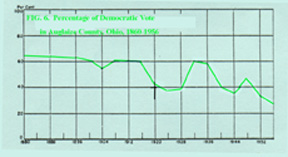
Auglaize County, Ohio, fits fairly well the specifications for an electoral unit to use to test the
expectation of a secular decline in group solidarity. As late as 1880, 10 per cent of its population
was German born. By 1950 it had become only 39 per cent urban. Long predominantly a
Democratic county, by the turn of the century Democratic presidential candidates came to have
less and less appeal to the county's voters. The trend in the voting record of the county from1880
to 1956 appears in Figure 6. Superimposed on the general trend line are deviations that reflect
the circumstances of particular elections. Someof these deviations ran counter to the secular
trend while others ran aheadof the trend. The effects of the two world wars on voters of
Germanic origin appear in the 1920 and 1940 dips in the curve while the Democratic upsurge of
the depression show up in the 1932 and 1936 votes. Yet all these deviations occur around a
long-term decline in Democratic strength.
The trend that appears in Figure 6 doubtless embodies many changes other than that which concerns us--the supposed decline in the political homogeneity of a group. Yet the general direction of the movement and the occurrence elsewhere of similar long-term movements, give some basis for presuming that the phenomenon exists. Much shorter segments of what are probably long-term shifts are also revealed in survey data that permit contrasts between age groups or between generations. [8]
To locate a jurisdiction in which a group is apparently undergoing secular decline in solidarity and to plot the trend establishes only the direction of movement, not the underlying nature of the change. A partisan shift even over a long term may mean that group ties remain as strong as ever but that the position of the group vis-a-vis a changing set of party alternatives dictates a transfer of partisan allegiance. Or a category of persons may acquire, through a change in the impact of public policy upon it or through a change in its position in the social structure, a greater and greater political relevance which reflects itself in a growing political solidarity. Some of these possibilities are suggested by the data of Figure 7 which shows, in terms of registration rather than of voting, the shift in a Boston Jewish ward from 1928 to 1952. Over this period the ward moved from about 80 per cent Republican registration to 90 per cent Democratic. [9]
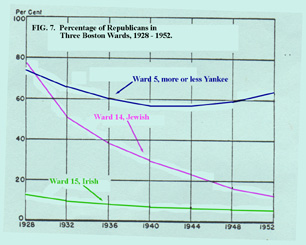
The chances are that long-term declines in group solidarity reflect a variety of underlying
factors. Political disintegration may parallel a decline in group clannishness generally. It may be
association with a decline in the political relevance of group characteristics through the
disappearance or settlement of old issues. The trend may, and probably often does, reflect not a
single factor operative continuously through time but the impact of separated events that happen
to push in the same direction. [10]
First, let it be said that whatever weight may be assigned to these secular processes, they occur along with short-term fluctuations in the partisan balance attributable to the events and issues of particular campaigns and elections. Attractive candidates or a fortunate sequence of events may operate to retard or to accelerate the long-term trend to theadvantage of one or the other of the parties. The descriptive model thatcommends itself is one of secular change (or many secular changesaffecting particular categories within the population) upon which aresuperimposed episodic fluctuations attributable to transientcircumstances. [11]
The question of their magnitude is critical for any assessment of theimport of these long-term changes for the character of the American partysystem as a whole. We may have identified an interesting curiosity ofimport principally in isolated localities. Yet, if one goes beyond theevidence presented here, it seems probable that the same kind of processhas affected large sectors of the American electorate and perhapscontributed significantly to the character of the American party system.A plausible hypothesis would be that the major shifts in partisan balanceover the history of the party system have been in considerable measurethe product of cumulative secular changes, changes that reflected bothrelative increases in the numbers of some sectors of the population and de declines as others as the gradual growth in political consciousness and solidarity of the swelling population categories. [12]
If these long-term processes have been of sufficient magnitude to affect the nature of the party system, they offer at least a partial explanation for some of the puzzling characteristics of the system. They help account for the fragility of the structures of power erected by American politicians; their foundations have simply been gradually undermined or their position slowly overwhelmed by the cumulative effects of great social changes and the associated partisan reorientations. Moreover, the slow rate of movement of the underlying secular movements may help explain why our great transfers of power and the accompanying shifts in public policy have been in the main peaceful. The slow build up of the political strength of rising groups, e.g., industrial labor, permits some accomodation by all concerned to the new order before it arrives. By the same token, the gradual infiltration of the leaders of new groups into the leadership echelons assures for them a degree of acculturation to the necessities in contrast with the circumstances when a green leadership is catapulted into power overnight. Similarly, the rate of the process of partisan change assures a lag in the decline of status of shrinking groups, a fact that may cushion the impact of the inevitable. And these processes may also help account for the non-doctrinaire quality of American party competition. The outs have not usually had to convert a substantial sector of the population to their philosophy to gain power; they have had simply to maneuver into position to exploit a growing stream of sentiment or interest. To be sure, the non-doctrinaire quality of American politics may help explain why secular realignments occur.
If the general analysis is correct, doubtless secular changes affecting major segments of American society now in process will in due course profoundly affect the party system. The identification and projection of those trends may be a major undertaking, but some of the tendencies are plain enough. The blue-collar sector has long since reached its peak; the white-collar sector continues to expand. The dispatches the day after election assay the effects of these trends, but the odds are that the full consequences are still in the making and that their precise nature has not yet been discerned. Gradual changes internal to such categories of electors, (e.g., the extraordinary alterations in the character and conditions of farming), have yet to make themselves felt. The geographical redistribution of population may also produce reorientations, not simply the redistribution of partisans but the formation of sectors of the electorate with new outlooks and interests. The surburban revolution has been heralded, but the odds are that the full consequences of the suburban movement, if any, will not be felt for decades. The mere mention of such possibilities suggests the importance for the nature of theAmerican party system of its existence within a society that is characteristically undergoing broad social and economic changes in contrast with the consequences for party systems of relatively static, if not stagnant, societies. [13]
*The assistance of John R. Rodman in the statistical work for thisarticle b gratefully acknow-ledged.
[1] Key, "A Theory of Critical Electioru," JOURNAL or POLITICS, XVII (February, 1955), 3-18.
[2] The values shown in Figure 1 for 1912 are the Democratic percentage of the three-party vote; for 1924, the Democratic vote plus the Progressive vote as a percentage of the three-party vote.
[3] The Maine data, when arranged in the manner of Figure 1, show a growth in dissimilarity of the cleavages in the industrial town and in the remainder of the state similar to that in New Hampshire.
[4] When the New Hampshiredata re arranged as in Figure 3, they show a like increase in Democratic reliance upon urban support. Such an analysis appears in my Politics, Parties, and Pressure Groups (New York: 4th edition, 1958), p. 586.
[5] Some of those persons who appear in the surveys as corss-pressured may be in fact persons for whom an old group attachment is losing its primacy in political relevance and is being replaced by another.
[6] For the argument set forth here it is not necessary to assume the existence of group processes in the formation of norms and their enforcement. The term group is employed rather in the sense of categories of parsons possessing common characteristics: "classes," countrymen, urbanites, factory workers, national-origin groups, perhaps even liberals or conservatives.
[7] This analysis perhaps bears on the debate between the social scientists and the anti-social
scientists over the issue of determinism and free will. The data suggest that that debate may be about
the wrong question. Situational circumstances may well circumscribe choice in varying degrees both from
situation to situation and among different persons in a particular situation. Moreover, situational
circumstances may influence toward a range of consequences.
[8] Thus in Elmira differences between Catholics and Protestants were sharpest among older people; young Catholics were more Republican than their eleders; Young Protestants, more Democratic than theirs. B. Berelson, et al., VOTING (Chicago, 1954), p. 70.
[9] I am indebted to Lawrence H. Fuchs for the data for Figure 7. See also his The Political Behavior of American Jews (Glencoe, 1956).
[10] To be differentiated from the types of partisan change mentioned in the text is that which occurs with the migration of partisans from one area to another. States and localities from time to time undergo a gradual shift in partisan allegiance largely from an influx of newcomer. Thus, the movement of northern Republicans to Florida over several decades has gradually increased that state's Republican vote.
[11] A consequence of a secular trend toward solidarity of one group maywell be a like trend toward concentration of an antithetical group on the other side of the party line.
[12] To check the plausibility of these notions the reader can apply them to the broad shifts in partisan balance over American party history. Thus, the great sectional political aggregates seem not to have been the creationof a day but to have come into being over considerable periods. Industrial labor came into its own politically long after it reached its peak in numbers. Unfortunately, the detailed testing of the broad argument on a large scale would be extraordinarily difficult. Not the least of the difficulties is the probability that steps occur in the development of group partisan orientation prior to its expression in the vote.
[13] If the general analysis has validity, the odds are that the party systems of western European
nations will during the nest few decades undergo striking changes in consequence of the extraordinary
eonomic developments. recently under way in these nations.
| BACK to the POSC420 Home Page | Top |